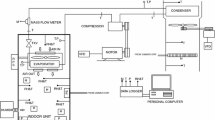Abstract
The thermodynamic characteristics of a compact thermoelectric (TE) air conditioner were investigated from a perspective based on exergy. A new efficiency is developed that is useful in studying TE performance resulting in possible improvement. Exergy analysis is applied to a TE system and its components, and exergy flows and efficiencies are evaluated. It was found that the exergy decreased as the electric current supplied to the TE air conditioner increased. Maximum exergy efficiency was 0.088 with a corresponding cooling capacity of 28.6 W. The exergy efficiency of the compact TE air conditioner was found to be relatively very low when compared with the respective coefficient of performance.
Similar content being viewed by others
Abbreviations
- COP:
-
Coefficient of performance
- Ex d :
-
Exergy destruction (W)
- Ex i :
-
Exergy inflow (W)
- Ex o :
-
Exergy outflow (W)
- I :
-
Current of the TE modules (A)
- K :
-
Thermal conductivity of TE elements (W/K)
- N :
-
Number of TE couples
- P :
-
Power input to the TE air conditioning system (W)
- Q c :
-
Cooling capacity of the cold side (W)
- Q h :
-
Heating capacity of the hot side (W)
- R :
-
Electrical resistance of TE elements (Ω)
- S g :
-
Entropy generation (W/K)
- T c :
-
Cold side temperature of TE module (K or °C)
- T h :
-
Hot side temperature of TE module (K or °C)
- T ca :
-
Cold air temperature (K or °C)
- T ha :
-
Hot air temperature (K or °C)
- T o :
-
Surrounding temperature (K or °C)
- α :
-
Seebeck coefficient (V/K)
- η Ex :
-
Exergy efficiency
References
D.L. Jones, Architecture and the Environment: Bioclimatic Building Design (London: Laurence King, 1998).
S. Jeong, Int. J. Refrig. 27, 309 (2004).
S. Maneewan, W. Tipsaeprom, and C. Lertsatitthanakorn, J. Electron. Mater. 39, 1659 (2010).
T.J. Kotas, The Exergy Method of Thermal Plant Analysis (Melbourne: Krieger, 1995).
M.A. Rosen, Int. J. Energy Res. 23, 415 (1999).
M.A. Rosen and I. Dincer, Int. J. Energy Res. 27, 415 (2003).
M.M. Talbi and B. Agnew, Appl. Therm. Eng. 20, 619 (2000).
A. Bejan, Advance Engineering Thermodynamics (New York: Wiley, 1988).
N.L. Pierres, M. Cosnier, L. Luo, and G. Fraisse, Int. J. Energy Res. 32, 1316 (2008).
Y. Bi, X. Wang, Y. Lin, H. Zhang, and L. Chen, Appl. Energy 86, 2560 (2009).
Y.J. Dai, R.Z. Wang, and L. Mi, Renew. Energy 28, 949 (2003).
Author information
Authors and Affiliations
Corresponding author
Rights and permissions
About this article
Cite this article
Tipsaenporm, W., Rungsiyopas, M. & Lertsatitthanakorn, C. Thermodynamic Analysis of a Compact Thermoelectric Air Conditioner. J. Electron. Mater. 43, 1804–1808 (2014). https://doi.org/10.1007/s11664-013-2879-2
Received:
Accepted:
Published:
Issue Date:
DOI: https://doi.org/10.1007/s11664-013-2879-2




